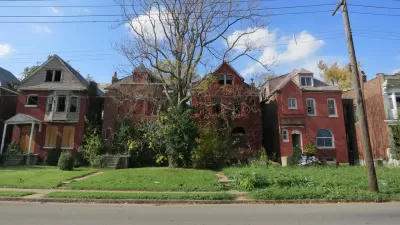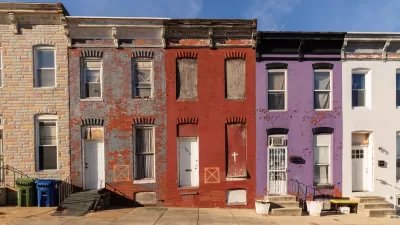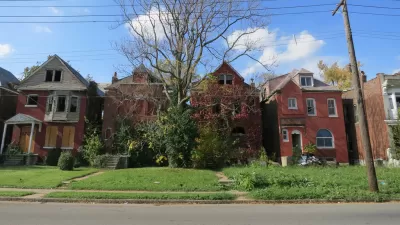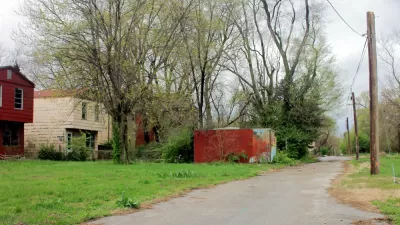Over the course of a year beginning in June 2008, a 'mysterious holding company' named Urban Assets bought 240 parcels across a five-mile swath of the north side of St. Louis. Since then, it's just let them decay.

"Rotting vacant buildings and scofflaw speculators are nothing new on the city’s north side, where decades of population loss have left some blocks more than half-empty and thousands of once-grand brick homes to rot," observes Tim Logan. "But city officials and neighborhood activists say they’ve never seen anything like Urban Assets, which bought up property in a flurry in 2008 and 2009, made no improvements and left tax bills unpaid and court summonses unanswered. Now this summer, their properties have started to hit the auction block for the unpaid taxes, but buyers are few, and most appear bound for the city’s already-swollen bank of property no one wants."
"The whole situation highlights the struggle the city faces in maintaining its valuable, but too-often-vacant, century-old red-brick building stock, and of pushing owners to take care of their property without pushing so hard they walk away."
FULL STORY: Mysterious firm bought more than 240 city properties, then did nothing

Study: Maui’s Plan to Convert Vacation Rentals to Long-Term Housing Could Cause Nearly $1 Billion Economic Loss
The plan would reduce visitor accommodation by 25,% resulting in 1,900 jobs lost.

North Texas Transit Leaders Tout Benefits of TOD for Growing Region
At a summit focused on transit-oriented development, policymakers discussed how North Texas’ expanded light rail system can serve as a tool for economic growth.

Why Should We Subsidize Public Transportation?
Many public transit agencies face financial stress due to rising costs, declining fare revenue, and declining subsidies. Transit advocates must provide a strong business case for increasing public transit funding.

How to Make US Trains Faster
Changes to boarding platforms and a switch to electric trains could improve U.S. passenger rail service without the added cost of high-speed rail.

Columbia’s Revitalized ‘Loop’ Is a Hub for Local Entrepreneurs
A focus on small businesses is helping a commercial corridor in Columbia, Missouri thrive.

Invasive Insect Threatens Minnesota’s Ash Forests
The Emerald Ash Borer is a rapidly spreading invasive pest threatening Minnesota’s ash trees, and homeowners are encouraged to plant diverse replacement species, avoid moving ash firewood, and monitor for signs of infestation.
Urban Design for Planners 1: Software Tools
This six-course series explores essential urban design concepts using open source software and equips planners with the tools they need to participate fully in the urban design process.
Planning for Universal Design
Learn the tools for implementing Universal Design in planning regulations.
City of Santa Clarita
Ascent Environmental
Institute for Housing and Urban Development Studies (IHS)
City of Grandview
Harvard GSD Executive Education
Toledo-Lucas County Plan Commissions
Salt Lake City
NYU Wagner Graduate School of Public Service





























